If you haven’t tried this creamy tahini sauce on roast chicken, you’ve been missing out
Joseph Abboud reveals the recipes for four favourite dishes from his Melbourne Middle Eastern restaurant Rumi.
Fried cauliflower with caramelised onion, currants and pine nuts hasn’t budged from the menu since the day Rumi opened in a tiny Brunswick East corner shop in 2006 (it has since relocated to East Brunswick Village).
Deep-fried until almost burnt-looking, the dish was a surprise hit at a time when the only cauliflower you’d find on menus “was the unwanted friend of broccoli and carrots at the pub, or at a French restaurant covered in sauce mornay”, Abboud writes in his recently released cookbook, Rumi: Food of Middle Eastern Appearance.
Abboud writes that he has shared the recipes for the cult cauli dish and all the restaurant’s other favourites with a little trepidation, “not because they are guarded secrets, but because their simplicity may surprise you”.
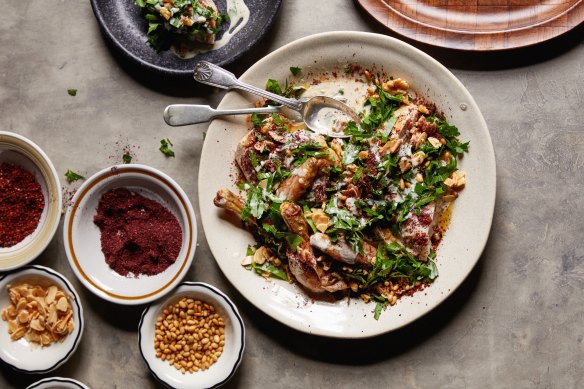
Tahini chicken
This is a dish that I can’t believe is not more commonplace. It is basically a chicken version of the classic Lebanese baked fish dish samke harra. In this recipe, the chicken is smothered in taratoor (see recipe below) and finished with various nuts, parsley and chilli. This version is made with roasted chicken, but you could steam, bake or poach the chicken, too.
INGREDIENTS
- 1 free-range chicken
- 1 tbsp vegetable oil
- 1 tbsp salt
- 1 tsp baharat (see recipe)
- 1 quantity taratoor (see recipe)
- 50g fried almonds (see below)
- 1 tbsp fried pine nuts (see below)
- 50g walnuts, chopped
- 1⁄2 bunch of flat-leaf parsley, shredded
- 1 tbsp ground sumac
- 1 tsp Turkish chilli powder (see note)
METHOD
- Remove the chicken from the fridge about 20 minutes before you want to cook it and preheat your oven to 200C fan-forced (220C conventional).
- Rub the vegetable oil all over the chicken then season with the salt and baharat. Place in a roasting tin and cook for about 1 hour and 20 minutes. To check that your chicken is cooked, pierce the thigh with a knife – the juices should be clear. Remove from the oven and allow to rest for about 20 minutes before carving. Lower the oven temperature to 180C fan-forced (200C conventional).
- Take the bird apart by removing the legs and cutting them into thighs and drumsticks. Remove the breasts from the bone and cut each breast into two or three pieces. Pick the rest of the meat off the carcass and add to the pile of chicken pieces.
- Drain the fat and excess juices out of the tray and set aside (see note). Place the cut chicken in the tray and pour the taratoor over it. Return to the oven for 5 minutes. Serve on your platter of choice topped with the mixed nuts, parsley, sumac and Turkish chilli.
Serves 4-8
Notes:
- Turkish chilli powder, also known as urfa biber, maras or isot powder, is a sun-dried red chilli often described as having a smoky and raisiny flavour.
- After draining most of the fat away from the juices (and discarding it), you could warm the remaining pan juices and drizzle over the chicken before serving.
- Leftovers can be shredded and served with crispy bread or used to make an excellent sandwich filling.
Baharat
This is a very simple soft spice house mix that can be used to enhance literally anything from barbecue to tabbouleh.
INGREDIENTS
- 20g ground cinnamon
- 15g ground black peppercorns
- 15g ground nutmeg
- 10g ground allspice
- 5g ground cloves
METHOD
Mix all the ingredients well and store in an airtight jar or container for 3-6 months.
Makes 65g
Taratoor
Tahini sauce, correctly called “taratoor”, is a versatile sauce that is traditionally used on anything from falafel to baked fish. I find myself reaching for it time and time again when looking for a creamy addition to many dishes, especially if they are vegan. We often have guests double-checking that the dishes with tahini in them are, in fact, vegan due to the richness that comes from the taratoor.
INGREDIENTS
- 80ml (⅓ cup) lemon juice
- 2 tbsp verjuice
- 10g garlic, crushed to a fine paste
- 8g salt
- 1 tbsp extra virgin olive oil
- 200g tahini
METHOD
- Place all the ingredients in a jar or container, in the order in which they’re listed, with 150ml water. Seal with a tight-fitting lid and shake, shake, shake!
- The sauce may be very thick depending on the tahini, but it can be easily adjusted with a touch of water. You want it to be the consistency of pure cream. This sauce will also thicken after refrigeration. Just add a little water to adjust the consistency. Store in an airtight container in the fridge for up to 2 weeks.
Makes 400ml
Fried flaked almonds
INGREDIENTS
- 500ml (2 cups) vegetable oil, for deep-frying (see note)
- 95g (1 cup) flaked almonds
METHOD
- Heat the oil in a saucepan over a medium–high heat. You’ll know it’s hot enough when a couple of almonds dropped into the oil sizzle gently. Place the rest of the almonds into the hot oil.
- This will temporarily reduce the temperature of the oil, but stir occasionally, and the temperature will come back up and the almonds will start to sizzle. Turn the heat down to low and stir more frequently until the nuts are light brown.
- Because the nuts will continue to cook even after you take them out of the oil, quickly drain them in a strainer, allowing any excess oil to drain away. They will smell fantastic but don’t be tempted to taste them straight away, as they will be VERY hot.
- Spread the nuts on a plate or tray lined with paper towel and allow to cool before storing in a sealed container in the fridge for up to 3 months.
Makes 95g (1 cup)
Fried pine nuts
INGREDIENTS
- 500ml (2 cups) vegetable oil, for deep-frying (see note)
- 95g (1 cup) pine nuts
METHOD
- Heat the oil in a saucepan over a medium-high heat. You’ll know it’s hot enough when a couple of pine nuts dropped into the oil sizzle gently. Place the rest of the pine nuts into the hot oil.
- This will temporarily reduce the temperature of the oil, but stir occasionally and the temperature will come back up and the almonds will start to sizzle. Turn the heat down to low and stir more frequently until the nuts are light brown.
- Because the nuts will continue to cook even after you take them out of the oil, quickly drain them in a strainer, allowing any excess oil to drain away. They will smell fantastic but don’t be tempted to taste them straight away, as they will be VERY hot.
- Spread the nuts on a plate or tray lined with paper towel and allow to cool before storing in a sealed container in the fridge for up to 3 months.
Makes 95g (1 cup)
Note:
Deep frying has a bad reputation as it is most commonly associated with processed fast food, but it is a key part of many cuisines, Middle Eastern being one of those. Whether it is frying sweet or savoury filled pastries, bittersweet dark brown vegetables or crispy onions, a pot of oil or a deep-fryer is never too far away. A neutral oil like cottonseed or canola works best, as it can handle higher temperatures, and I highly recommend an electric benchtop fryer. Even a tiny domestic fryer from a department store will make life easier. Lacking that, I suggest you heat a pot of oil on the store to around 180C, but bear in mind that a pot on the stove can be a fire hazard, whereas a small deep-fryer will have a safety cut-off.
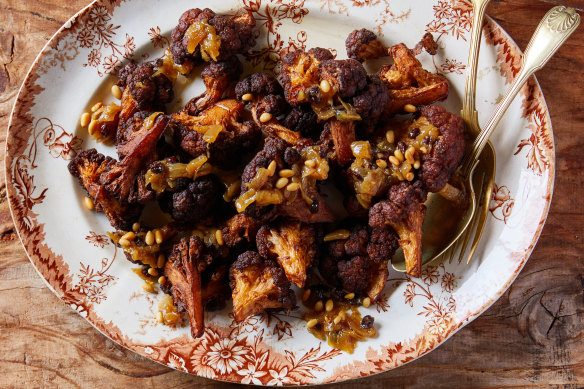
Fried cauliflower with caramelised onion, currants and pine nuts
If you make this dish correctly, you’ll be asking yourself whether you’ve burnt it. It’s OK. My training in modern European kitchens, where everything had to be golden brown, had me second-guessing, too. But it just doesn’t taste the same if it is golden brown. It’s that dark bittersweet flavour that transforms cauliflower.
INGREDIENTS
- 100ml vegetable oil
- 2 tsp pine nuts
- 2 onions, cut into 2cm squares
- salt, to taste
- small pinch of ground allspice
- 1 tbsp currants
- 1 small head of cauliflower
- oil, for deep-frying (see note)
- plain flour, for dusting
METHOD
- Heat a small frying pan over a low heat and add 2 tablespoons of the vegetable oil and the pine nuts. Fry gently until the pine nuts start to change colour and become golden. At this point, strain through a small sieve and spread them on a plate or tray lined with paper towel. They will continue to colour so be sure to take them off the heat before they get too brown.
- Heat the remaining oil in a small saucepan over high heat until very hot, then add the onion, stirring frequently until it starts to colour. Turn down the heat to low and allow the onion to caramelise slowly. Cook for about 30 minutes until completely soft and dark brown. Season with salt and allspice, then add the currants, stirring through the onion until well combined. Remove from the heat.
- For the cauliflower, fill a saucepan with heavily salted water and bring to a rolling boil. Cut the cauliflower into florets at least the size of a golf ball and no bigger than a mandarin. Boil in the salted water for 8-10 minutes until soft, then remove from the water with a kitchen spider or strain through a sieve. Spread on a tray lined with paper towel or a tea towel and allow to cool and dry out a little.
- When ready to fry, heat the oil in a saucepan or deep-fryer (see note below) to 180C. Dredge the cauliflower in the flour then shake off any excess in a sieve. Fry until dark brown. Yes – DARK!
- Remove from the oil and drain on some paper towel. Season with salt and pepper, then arrange on a plate and top with the caramelised onion, currants and pine nuts.
Serves 6-8
Notes:
- You can use chickpea flour (besan) for dusting for a gluten-free result.
- If you prefer to steam (not boil) the cauliflower, that is fine. Be sure to sprinkle with lots of salt before it goes into the steamer.
- The onions and the boiling of the cauliflower can be done a few days in advance. Be sure to warm the onion mix slightly before using it.
- The pine nuts can also be prepared days in advance. If you have become a fan of frying nuts, you can fry a larger batch (see note). They will keep in the fridge for up to 3 months.
- The traditional accompaniment for this fried cauliflower is taratoor (see recipe).
- Leftover fried cauliflower goes beautifully in a flatbread sandwich drizzled with taratoor.
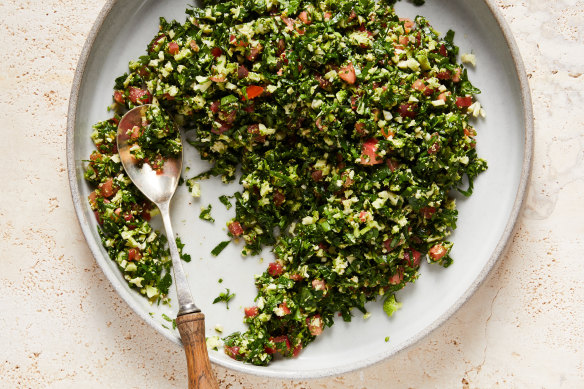
Broccoli tabbouleh
If there’s one recipe I suggest you take from this book and share with your family and friends, it’s this one. It is inspired by my wife Nat’s raw broccoli salad, which is a regular feature of our family table. I came up with this recipe on one of the rare occasions I was making dinner for the kids. Looking for inspiration that would do her proud and not be outright rejected by the kids, I found some broccoli in the fridge and thought I’d have a go at her salad, which normally contains chopped raw broccoli, toasted almonds and pepitas (pumpkin seeds), and Persian feta. Instead, somehow, I made a connection between the texture of raw broccoli and the texture of burghul, which is an integral ingredient in tabbouleh. Broccoli tabbouleh was born. And it’s gluten-free! I think I’m pretty clever with this one.
INGREDIENTS
- 1 large head of broccoli
- 2 ripe tomatoes, cut into 5mm dice
- 1 bunch of flat-leaf parsley, leaves picked then finely chopped
- ¼ bunch of mint, leaves picked then shredded
- 75ml (⅓ cup) lemon juice
- 150ml extra virgin olive oil
- 1 tsp Lebanese seven spice (see note)
- 2 spring onions, finely sliced
- ½ tsp salt
METHOD
- Trim the broccoli of the fibrous end, then chop the tender stem and florets as finely as you can.
- Place all the ingredients in a bowl and mix together. Be sure that everything is well coated with the lemon juice and olive oil. I would suggest leaving it for 5 minutes after mixing then coming back to it with any adjustments to the seasoning – it should be juicy and salty!
Serves 8
Note:
Lebanese seven spice (not to be confused with Japanese seven spice), is available at some supermarkets and specialist grocers. To make your own, add 15g each of ground cumin and coriander to the baharat spice mixture below.
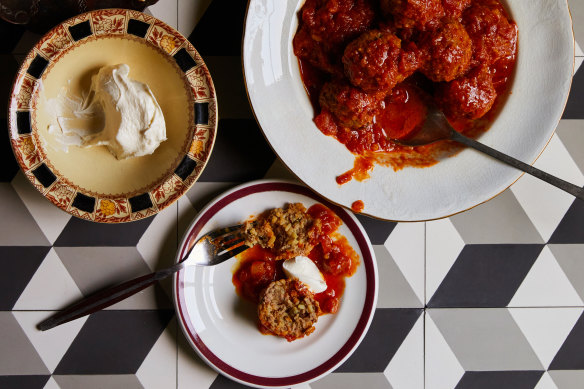
Rumi meatballs
These meatballs have been on the menu since the day we opened and are inspired by the Persian recipe kofte tabrizi, a giant meatball stuffed with eggs, onions and dried fruit. The combination of meat and rice makes the meatballs beautifully delicate. They are great for kids, too.
INGREDIENTS
Meatballs
- 110g (½ cup) medium-grain rice
- 1 small onion, grated or minced in a food processor
- 500g minced lamb
- 1 egg
- ½ bunch of flat-leaf parsley, finely chopped
- 1 tsp advieh (see recipe)
- 2 tsp salt
- 1 tsp saffron water (see recipe)
Sauce
- 1 onion, finely diced
- 100ml extra virgin olive oil
- 1kg tinned chopped tomatoes
- 2 tsp salt
METHOD
- Bring the rice to the boil in a saucepan of water set over high heat and boil until only just cooked. Drain, then chill. (This can be done the day before.)
- To make the meatballs, place all the ingredients in a large bowl, ensuring that your rice is also cold, and mix vigorously until well combined.
- Divide the mixture into pieces about 50g each. Roll into neat balls and refrigerate until the sauce is ready.
- Now, make the sauce in a wide-based pan large enough to eventually accommodate the meatballs in one to two layers.
- Sweat the onion in the olive oil for about 10 minutes over low heat. This is an important step as you want to draw the sweetness out of the onion, which should be cooked until translucent.
- Add the tomatoes, bring to a boil, then reduce the heat to medium-low and cook for a further 30 minutes. Stir in the salt, then add 125ml (½ cup) of water and bring back to a simmer.
- Gently drop the meatballs into the sauce, ensuring they all sink down well, and monitor until the sauce returns to the boil. Turn the heat down to a very low simmer and cook for another 30 minutes.
Serves 6-8, or makes 18 meatballs
Advieh
Advieh is Iran’s version of India’s garam masala or Morocco’s ras el hanout. It’s a spice mix that differs from place to place depending on the use and region. It contains many of the usual suspects, such as cumin, cinnamon and nutmeg, as well as the dried rose and dried lime that are more unique to Persian cuisine. I don’t know where this recipe began, but I have made adjustments along the way to make it my own.
INGREDIENTS
- 50g ground cinnamon
- 50g ground cumin
- 35g ground coriander
- 30g ground nutmeg
- 20g dried lime powder (see note)
- 15g golpar powder (see note)
- 15g ground turmeric
- 15g ground black peppercorns
- 15g ground cardamom
- 10g dried rose powder
METHOD
Mix all the ingredients well and store in an airtight jar or container for 3-6 months.
Makes 250g
Notes:
- Dried limes, also known as black limes, are used whole, sliced or ground, as a spice in Middle Eastern dishes. They are available in Middle Eastern grocers. They’re not easy to grind but it’s worth doing so. When you buy them already ground, their powder is bitter because they are ground with the seeds. If you are going to the effort of grinding them yourself, cut them in half and remove the seeds before crushing and grinding in a coffee or spice grinder. Otherwise, substitute sumac or grated lemon zest.
- Golpar is a mysterious ingredient with a mild curry-like flavour. I have found it listed as anything from wild parsley to angelica. I don’t believe it is actually either of those. You’ll have to buy it from Persian or Afghan grocers.
Saffron water
Turning your saffron threads into a liquid that is potent and ready to use will change your life! Well, maybe not your life, but it will definitely change how and when you use saffron. This method of toasting then grinding into a genuine saffron powder also extends the yield you get from a very expensive ingredient. It lasts weeks if not months in the fridge and is great to have on hand to use in anything from rice to ice cubes.
INGREDIENTS
- 1g saffron
- ½ tsp sugar
METHOD
- Lightly toast the saffron in a dry frying pan over a medium heat until fragrant. Do not allow it to darken. You want to just warm the saffron gently to dry it a little further.
- Remove from the pan and place in a mortar and pestle or spice grinder with the sugar. Grind the saffron and sugar to a fine powder and tip into a glass jar.
- Boil 200ml water and tip it into the jar over the saffron. Seal with a lid and, once cooled, store in the fridge for future use. It will keep for up to 2 weeks.
Makes 200ml
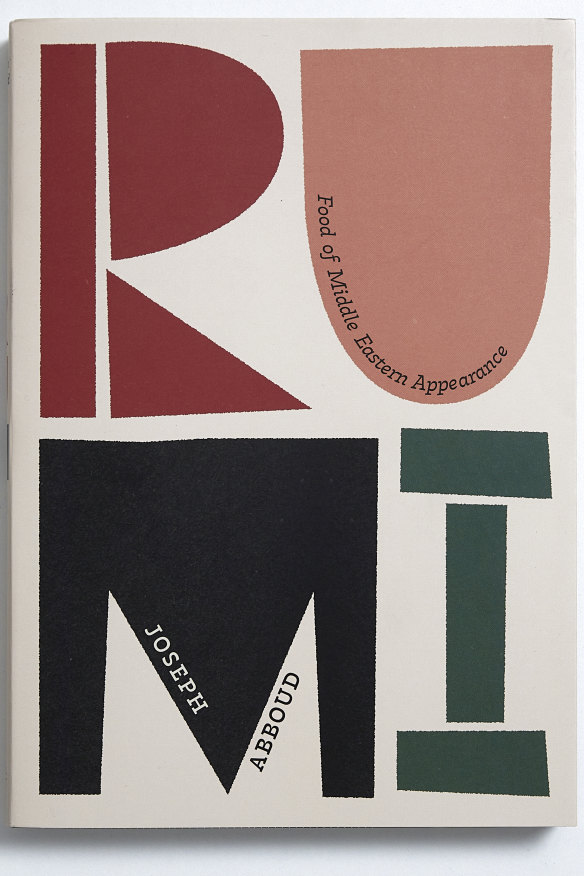
This is an edited extract from Rumi: Food of Middle Eastern Appearance by Joseph Abboud, photography by Armelle Habib. Murdoch Books, RRP $39.99. It is available through Booktopia here.
Appears in these collections
The best recipes from Australia's leading chefs straight to your inbox.
Sign up